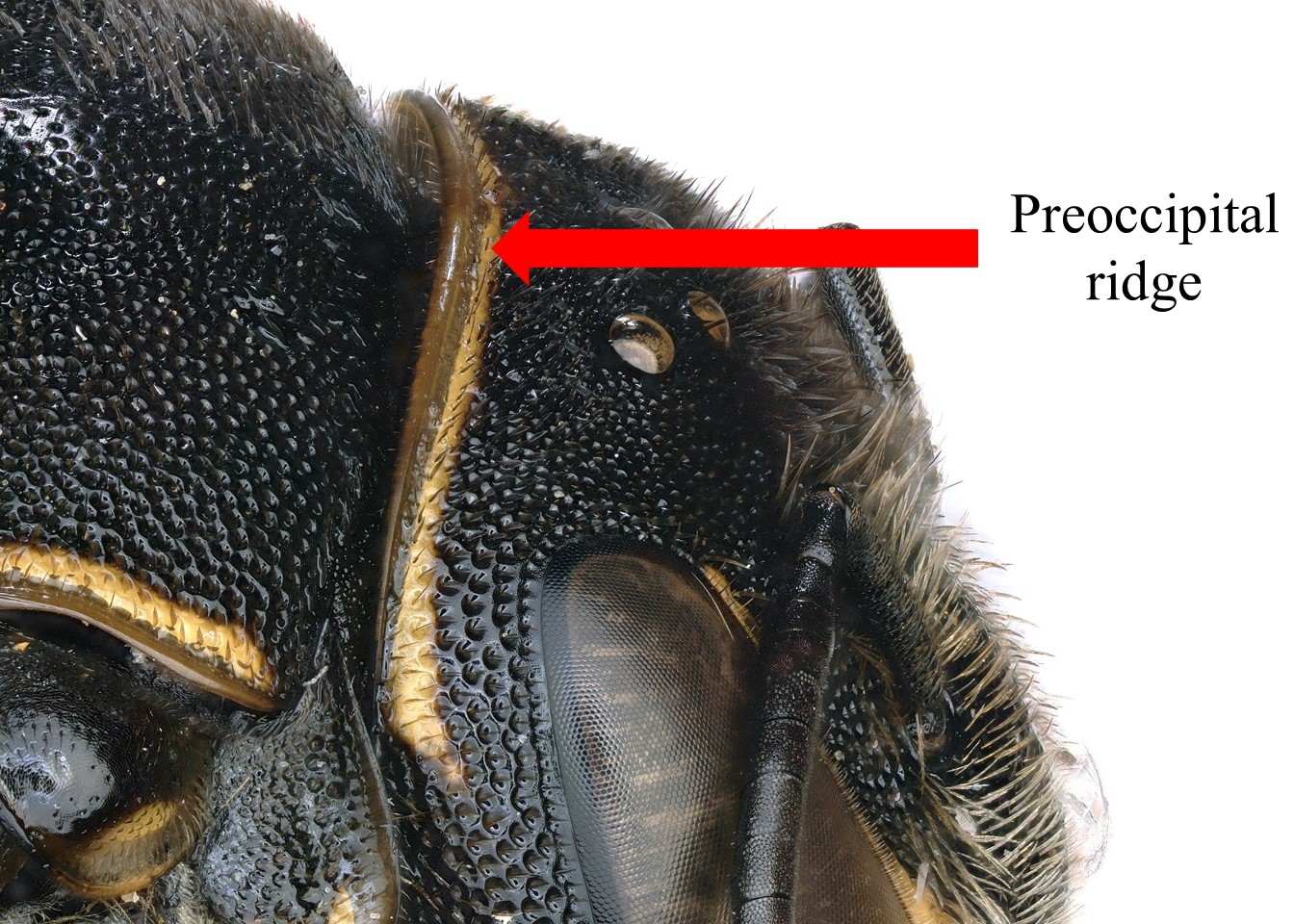Family: Megachilidae
Subfamily: Megachilinae
Tribe: Anthidiini
Genus: Pachyanthidium Friese, 1905
Subgenera: Ausanthidium, Pachyanthidium, Trichanthidioides, Trichanthidium
Common name: none
Pachyanthidium are robust bees ranging in body length from 5–12 mm (Michener 2007Michener 2007:
Michener, C.D. 2007. The Bees of the World (2nd ed.). Johns Hopkins University Press, Baltimore and London, 953 pp.). Coloration can be entirely black, black integumentintegument:
a tough, protective outer layer
with yellow maculations, or black head and thorax with a red abdomen (Michener 2007Michener 2007:
Michener, C.D. 2007. The Bees of the World (2nd ed.). Johns Hopkins University Press, Baltimore and London, 953 pp.).
Pachyanthidium contains 16 species (Michener 2007Michener 2007:
Michener, C.D. 2007. The Bees of the World (2nd ed.). Johns Hopkins University Press, Baltimore and London, 953 pp.); none are known to occur in the U.S. or Canada.
(modified from Michener 2007Michener 2007:
Michener, C.D. 2007. The Bees of the World (2nd ed.). Johns Hopkins University Press, Baltimore and London, 953 pp.)
 is half as wide as T1T1:
is half as wide as T1T1: and T2T2:
and T2T2: .
. lamellatelamellate:
lamellatelamellate: lamellatelamellate:
lamellatelamellate:Some Pachyanthidium may be confused with Euaspis due to the presence of a produced, flat scutellumscutellum:
shield shaped plate behind scutum, two apicalapical:
near or at the apex or end of any structure
spines on the fore and middle tibiaetibiae:
the segment of the leg, between the femur and the tarsus, and similarly colored red abdomens in certain species. Additionally, male Pachyanthidium and Euaspis have a trilobed T7T7:
the segments on the top side of the abdomen, often abbreviated when referring to a specific segment to T1, T2, T3, T4, T5, T6, or T7 and a large, rounded gonostylusgonostylus:
and a large, rounded gonostylusgonostylus:
the apical-most appendage of the male genitalia, which is usually quite hairy
. Pachyanthidium can be readily distinguished by the lack of juxtantennal carinacarina:
a clearly defined ridge or keel, not necessarily high or acute; usually appears on bees as simply a raised line
and a raised median ridge from the fronsfrons:
the area between the antennae and ocelli on the bee's head to the supraclypeal areasupraclypeal area:
the region of the head between the antennal sockets and clypeus, demarcated on the sides by the subantennal sutures, which are present in Euaspis (Michener 2007Michener 2007:
Michener, C.D. 2007. The Bees of the World (2nd ed.). Johns Hopkins University Press, Baltimore and London, 953 pp.). Female Euaspis can also be differentiated from Pachyanthidium due to the lack of a scopascopa:
modified hairs for carrying pollen; often branched and dense hairs on the hind-leg, or on the ventral surface of the abdomen in Megachilidae
, a carinacarina:
a clearly defined ridge or keel, not necessarily high or acute; usually appears on bees as simply a raised line
on the preoccipital ridgepreoccipital ridge:
the carina that dorsolaterally surrounds the back of the head , and a broad-toothed apexapex:
, and a broad-toothed apexapex:
end of any structure
of the mandiblemandible:
bee teeth, so to speak, usually crossed and folded in front of the mouth (Michener 2007Michener 2007:
Michener, C.D. 2007. The Bees of the World (2nd ed.). Johns Hopkins University Press, Baltimore and London, 953 pp.).
There are no known invasives.
Females have been observed gathering latex from Euphorbia (Michener 2007Michener 2007:
Michener, C.D. 2007. The Bees of the World (2nd ed.). Johns Hopkins University Press, Baltimore and London, 953 pp.). Pachyanthidium cordatum has also been observed collecting resin and pollen from Dalechampia capensis (Steiner and Whitehead 1991Steiner and Whitehead 1991:
Steiner, V.B. and K.E. Whitehead. 1991. Resin collection and the pollination of Dalechampia capensis (Euphorbiaceae) by Pachyanthidium cordatum (Hymenoptera: Megachilidae) in South Africa 54: 67ndash;72.).
Pachyanthidium bicolor constructs cells of resin or plant hairs adjacent to one another on leaves (Michener 1968Michener 1968:
Michener, C.D. 1968. Nests of some African megachilid bees, with description of a new Hoplitis (Hymenoptera: Apoidea). Journal of the Society of the Entomological Society of Southern Africa 31: 337ndash;359.). Pachyanthidium cordatum has been observed using plant down glued together with resin (Steiner and Whitehead 1991Steiner and Whitehead 1991:
Steiner, V.B. and K.E. Whitehead. 1991. Resin collection and the pollination of Dalechampia capensis (Euphorbiaceae) by Pachyanthidium cordatum (Hymenoptera: Megachilidae) in South Africa 54: 67ndash;72.).
Pachyanthidium occurs throughout Africa in Namibia, Senegal to Ethiopia, South Africa, Kenya, Saudi Arabia, Ivory Coast to southern Egypt, and Angola, as well as in Asia from India to Yunnan Province, China (Michener 2007Michener 2007:
Michener, C.D. 2007. The Bees of the World (2nd ed.). Johns Hopkins University Press, Baltimore and London, 953 pp.).
Distribution map generated by Discover Life -- click on map for details, credits, and terms of use.
Michener, C.D. 1968. Nests of some African megachilid bees, with description of a new Hoplitis. Journal of the Entomological Society of Southern African 31:337-359.
Michener, C.D. 2007. The Bees of the World. 2nd ed. Johns Hopkins University Press, Baltimore and London, 953 pp.
Steiner, V.B. and K.E. Whitehead. 1991. Resin collection and the pollination of Dalechampia capensis (Euphorbiaceae) by Pachyanthidium cordatum (Hymenoptera: Megachilidae) in South Africa 54:67-72.